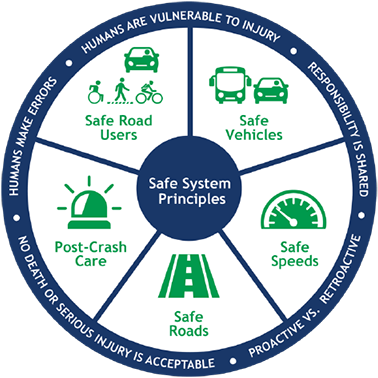← Return to Monthly Spotlight Archives
Highway Safety Improvement Program | December 2021

Safe System Approach. Source: FHWA
In Ohio, traffic fatalities have risen in six of the last seven years. To address this issue, the Ohio Department of Transportation (ODOT) made major changes to its Highway Safety Improvement Program (HSIP) to focus limited funding on fatal and serious injury crashes, an important distinction of the Safe System Approach (SSA). Changes also included encouraging systemic/proactive safety projects to prevent specific high-severity crash types—pedestrian and roadway departure. These efforts incorporate SSA elements and principles, which recognize that humans make mistakes and changes to roadway design and operations can assist in reducing crash severity.
ODOT incorporated SSA into its HSIP by updating its formal application for HSIP projects in August 2021. Revisions included changing the scoring criteria to better focus on fatal and serious injury crashes.
In addition, in January 2022 ODOT will begin accepting project applications that focus on preventing pedestrian and roadway departure crashes through systemic infrastructure improvements. Systemic safety improvements are meant to be proactive and widely implemented based on roadway features that have been associated with specific crash types.
ODOT has incorporated equity into its Safety Program as well. ODOT recognized that in Ohio, fatal and serious injury crashes were overrepresented by ten percent in areas with a poverty rate at or above ten percent, when adjusted for population. In these communities, applications can receive additional points and may be eligible for a reduced local match.
To advance the Safe Speeds element of the SSA, ODOT is incorporating bicycles and pedestrians into the speed study process. This includes making the presence of pedestrians and bicyclists a criterion for lowering speeds and allowing agencies to use a lower threshold for calculating driver speeds when making these decisions. In addition, ODOT is developing a new multi-modal design guide that Ohio agencies can use to consider the impact of roadway design on all road users—especially bicyclists and pedestrians. Designs that incorporate bike lanes, curb bump outs, reduced curb radii, and leading pedestrian intervals have been shown to reduce speed-related crashes and improve safety for everyone.
These program changes support implementation of the SSA in Ohio. Focusing on fatalities and serious injuries emphasizes the Safe System principle that death and serious injury is unacceptable. Systemic safety improvements for pedestrian and roadway departure crashes support the Safe System principle that Safety is proactive. Expanding opportunities for communities with fewer financial resources supports equity in the HSIP. The speed policy and design practice changes ensure that safety is addressed for all roadway users, not just motorists. ODOT has provided detailed fact sheets and resources on its website to continue to educate its stakeholders on the value of these changes. Throughout the process, applicants are gaining a greater awareness for the types of projects that can reduce fatalities and serious injury crashes.
RSPCB Program Point of Contact
Felix Delgado, FHWA Office of Safety
Felix.Delgado@dot.gov
FHWA Office of Safety
Staff and Primary Work Responsibilities
FHWA Office of Safety
Safety and Design Team
FHWA Resource Center